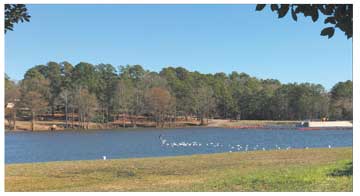 The water level in Hope Mills Lake is not something town officials want to raise and lower with any kind of frequency. As Don Sisko, head of the town’s public works department, explained, it’s good structural practice to leave the lake at as constant a level as possible.
The water level in Hope Mills Lake is not something town officials want to raise and lower with any kind of frequency. As Don Sisko, head of the town’s public works department, explained, it’s good structural practice to leave the lake at as constant a level as possible.
That’s why he suggested to town manager Melissa Adams that the level be lowered just once in the weeks ahead to deal with two situations at the lake. First, lowering the lake will give owners of property on the lake the annual opportunity to do maintenance to their piers and docks. Second, it will allow the town to install a planned bulkhead on the lake bank.
The actual date of the lowering of the lake won’t be determined until the town’s Board of Commissioners meets in late January and accepts a bid for work on the bulkhead and then establishes a date when that work will begin.
The town will then notify lakefront property owners about which dates to expect the lake to be lowered. When it is lowered, the property owners will be able to work on repairs for things that would normally be underwater.
Lowering the water level in winter also makes the lake healthier. The harsher weather kills exposed aquatic vegetation along the banks, including pond algae. A rapid increase of algae, or an algae bloom, can kill fish and remove oxygen from the water.
While the town has tentatively planned for the lake level to be lowered for about two weeks, Sisko said that is not an exact time frame. It will likely be longer than that, he said, because of the work required to install the bulkhead.
“The bulkhead is going to be installed on the opposite side of the boat ramp from the existing pier,’’ Sisko said.
“Part of its function will be to serve as an erosion control measure. Along with the bulkhead, we’re going to change the slope of that embankment. That will give us the opportunity to put in some backfill and make that a more gentle slope.’’
Sisko said the bulkhead will be made of specially treated wood, most likely pine.
The challenge for Sisko and the public works staff while the bulkhead is installed will be monitoring the lake level and making sure it stays low enough for the workers to operate in a dry environment.
“This is not an exact science,’’ Sisko said. “We’re not going to be able to keep the lake at a specific foot mark for any protracted period of time.’’
The biggest challenge will be monitoring rainfall after the lake is lowered and dealing with problems that will be caused if the rain is excessive, which could cause the lake to refill and force the opening of the sluice gates to drop the level further.
Sisko said people along the lake shouldn’t look for laborers to start work on the bulkhead until after bids are presented to the commissioners later this month.
Hope Mills Mayor Jackie Warner is hopeful the bulkhead installation process goes without complication so everything will be in place in plenty of time for this year’s annual lake festival in late May.
She doesn’t expect any problems regarding the homeowners and their repairs of their facilities since the water has been back in the lake for barely a year.
If anyone has questions about the lake lowering and installation of the bulkhead, they should contact the Hope Mills Public Works office at 910-423-2777.